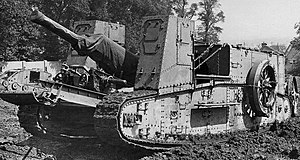Britit valmistivat tämän Mark I mallin ensimmäisen maailmansodan aikana.

Tankki joka kantoi tykkiä, ei paljoa muistuttanut muita sen ajan panssarivaunuja.
Telasto oli pitkä, matala, lähes tasainen. Vaunun takaosassa oli suorakaiteen muotoinen katettu päällysrakenne, johon oli asennettu Daimlerin 105 hv: n moottori yhdessä Mark I voiman siirron kanssa joka oli käännetyssä asennossa.
Vaunun miehistönä oli komentaja, mekaanikko ja kaksi vaihde miestä. Alkuperäinen takapäässä oleva kaksoispyörä (Mark I tapaan), jonka tarkoituksena on tukea ohjausta ja kiinnitetty ajoneuvon takana, säilytettiin. Vaunun etuosassa oli avoin alue, jossa joko 60-naulainen (5 tuuman) kenttä tykki tai 6 tuuman haupitsi.
Kuljettamista varten tykin pyörät poistettiin kuljetus ajaksi ja kiinnitettiin vaunun ulkopuolelle, sen kylkiin kunnes niitä tarvittiin uudelleen.
Periaatteessa molemmilla tykeillä voitaisiin ampua ajoneuvosta; todellisuudessa kuitenkin vain haupitsia voitiin käyttää ampumaan suoraan vaunusta.

Aseet voitiin kuormata ja lastatata kahden kääntyvän rullaus-telineen avulla, jotka saivat voimansa tankin moottorista. Edessä telarungon kummallakin puolella oli panssaroitu ohjaamo, kuljettajan vasemmalla, jarrumiehen oikealla puolella.
Prototyypin ohjaustila oli suoraan edessä korirakenteen päällä, seuraavissa malleissa näitä siirrettiin eteenpäin näkyvyyttä parantaen, mutta tämä teki viestinnän erittäin vaikeaksi. Pahin Mark I ongelmista oli ohjaaminen johon tarvittiin kaikkien neljän miehen (mukaan lukien vaihde-mies) yhteistyö tankin ohjaamiseen.
Heinäkuussa 1917 muodostettiin kaksi Gun Carrier komppaniaa,
molemmilla oli 24 vaunua joista yksikään ei toden näköisesti ampunut koskaan.
Koska läpimurtoja ei koskaan tullut, ajoneuvoja käytettiin kuljettamaan ammuksia
ja yhden vaunun on laskettu korvaavan 291 kuormaa kantavien miesten työt.
-----------------------------------------------------------------
The Gun Carrier Mark I was the first piece of self-propelled artillery ever to be produced, a British development from the First World War.
Place of origin: United Kingdom
Service history: Used by UK Wars World War I
Designed: July 1916
Manufacturer: Kitson & Co.
Produced: June - July, 1917
Number built: 48
Variants: Gun Carrier Crane, Gun Carrier Mark II (project only)
Weight: 28.45 t
Length: 9.75m
Height: 2.41 m
Crew: 4 + gun crew
Main armament: 60-pounder field gun or 6-inch howitzer
Engine: Daimler petrol engine 105 hp
Suspension: Unsprung
Operational range: 37.8 km
Speed: 5.95 km/h
The vehicle bore little resemblance to the Mark I. The tracks weren't tall but low, almost flat. At the back a rectangular superstructure covered the Daimler 105 hp engine together with the transmission of the Mark I, the latter now in a reversed position. Sharing it were the vehicle commander, a mechanic and two gearsmen.
The original double tail wheel of the Mark I, intended to aid steering and attached to the rear of the vehicle, was retained. The front was an open area with either a 60-pounder (5-inch) field gun or a 6-inch howitzer.
For transporting the gun only the wheels had to be removed from the gun carriage - these were attached to the side of the carrier until needed again. In theory, the field gun could be fired from the vehicle; in reality only the howitzer could be so used. Alternatively the guns could be unloaded through a pivoting cradle assisted by two winding drums driven by the engine.
Above the front of the track frame at each side was an armoured cab for the driver on the left and the brakesman on the right. In the prototype these driving positions were directly in front of the superstructure; moving them forward improved visibility, but made communication very difficult - a problem as, in the Mark I, four men (including the gearsmen) had to cooperate to steer the tank.
In July 1917 two Gun Carrier Companies were formed of 24 vehicles each. Probably none of them ever fired a shot in anger. As breakthroughs never materialised the vehicles were ultimately only used as supply tanks. It was calculated a single tank had the same carrying capacity as 291 human porters.

Salvage tank on a train on the way to the Battle of Cambrai, November 1917
Two vehicles out of the order of fifty were finished as Gun Carrier Cranes, salvage tanks with a hand-operated crane in the front. The forward cabs were absent.
There was a project for a Gun Carrier Mark II. Early in 1917 a wooden mock-up was made of an improved type, carrying the gun at the back. A real prototype was partly built, but never finished, the sole result of the project being that the original type is now known as the Gun Carrier Mark I.


Ei kommentteja:
Lähetä kommentti
Any explosive ammunition or empty cores, you can put in this.